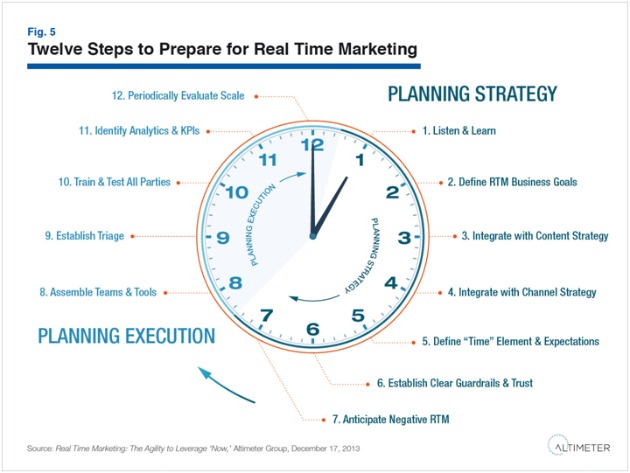
Part one of this two-part series examined how organizations plot strategy for real-time marketing (RTM), based on “Real Time Marketing: The Agility to Leverage ‘Now,’” research Altimeter Group recently published on the topic.
Once strategy is in place, it’s time to turn to RTM execution, in particular enabling it to happen in a seamless, scalable way.

Assemble team and tools
Successful RTM requires that the right constituents be available, informed, educated, and empowered. Assemble the proper teams (i.e., social, creative, copywriting, legal, PR, etc.) and tools (i.e., listening, analytics, design, digital assets, publishing tools, etc.) to ensure streamlined execution. Multiple companies we interviewed underscored the importance of having a “war room,” akin to a newsroom, where all team members are literally present and able to collaborate — in real-time.
For unplanned, reactive RTM execution, the existing content hub or social media team takes the lead. Alternately, a pre-identified and trained virtual team leaps into action.
For anticipated events, a war room is often the hub, driving real-time approvals, design, triage, and publication. Even brands without 24/7 RTM teams can assemble trained and prepared teams for special events, as Oreo did for the Super Bowl.
For anticipated or planned events with content created in advance, assemble teams with regularly scheduled meetings to discuss event strategies and guidelines and identify areas of opportunity.
Establish triage
Scenario-based triage is one of the single most effective ways to streamline RTM execution. Certain cues or events trigger repeatable workflows. Community managers should be able to identify what types of language indicate threats or risks for the brand, and how and when to escalate them to legal, PR, or the appropriate team. When developing RTM content, consider how users may respond, then identify what warrants response and build workflows based on positive and negative interactions or needs. The more detail provided, the more teams accounted for, and the more scenarios planned for, the better.
Train and test all parties
A big part of operating in real-time is enabling key employees to feel trusted and empowered to act. This level of confidence is only achieved via education and training across all stakeholders — not only those posting and responding but those creating, approving, distributing, and monitoring, both internally and externally (i.e., agencies and vendors). Training should include both strategic and tactical elements.
Training tools and testing will vary by organization based on resources and stakeholders. The goal of training and testing, however, is universal: to establish confidence for those executing and trust in them by all stakeholders, management, and the brand at large.
Please read the rest of this post on iMedia, where it originally published.
